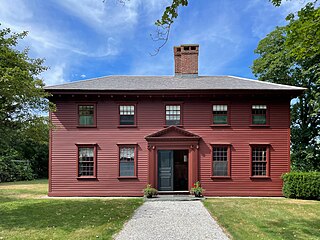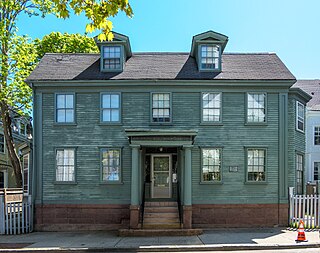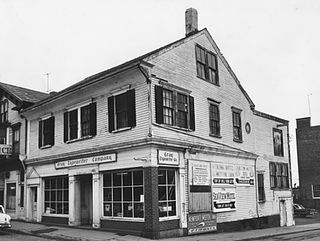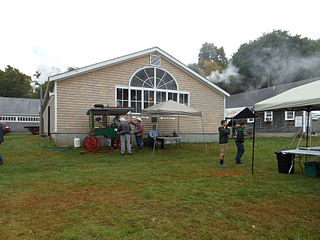
The First Baptist Meetinghouse, also known as the First Baptist Church in America is the oldest Baptist church congregation in the United States. The Church was founded in 1638 by Roger Williams in Providence, Rhode Island. The present church building was erected between 1774 and 1775 and held its first meetings in May 1775. It is located at 75 North Main Street in Providence's College Hill neighborhood. It was designated a National Historic Landmark in 1960. It is affiliated with the American Baptist Churches USA.

Chateau-sur-Mer is one of the first grand Bellevue Avenue mansions of the Gilded Age in Newport, Rhode Island. Located at 474 Bellevue Avenue, it is now owned by the Preservation Society of Newport County and is open to the public as a museum. Chateau-sur-Mer's grand scale and lavish parties ushered in the Gilded Age of Newport, as it was the most palatial residence in Newport until the Vanderbilt houses in the 1890s. It was designated a National Historic Landmark in 2006.

Hunter House (1748) is a historic house in Newport, Rhode Island. It is located at 54 Washington Street in the Easton's Point neighborhood, near the northern end of the Newport Historic District.

The Isaac Bell House is a historic house and National Historic Landmark at 70 Perry Street in Newport, Rhode Island. Also known as Edna Villa, it is one of the outstanding examples of Shingle Style architecture in the United States. It was designed by McKim, Mead, and White, and built during the Gilded Age, when Newport was the summer resort of choice for some of America's wealthiest families.

The Whitehall Museum House is the farmhouse modified by Dean George Berkeley, when he lived in the northern section of Newport, Rhode Island that comprises present-day Middletown in 1729–1731, while working to open his planned St Paul's College on Bermuda. It is also known as Berkeley House or Bishop George Berkeley House and was listed on the National Register of Historic Places in 1970.

Union Village or "Bank Village" is a village and historic district located in North Smithfield and Woonsocket, Rhode Island, United States on Rhode Island Route 146A. Union Village developed because it was at the crossroads of old Great Road and Pound Hill Road.

The Museum of Newport History is a history museum in the Old Brick Market building in the heart of Newport, Rhode Island, United States. It is owned and operated by the Newport Historical Society at 127 Thames Street on Washington Square. The building, designed by noted 18th-century American architect Peter Harrison and built in the 1760s, is a National Historic Landmark.

The Battle of Rhode Island Site is the partially preserved location of the Battle of Rhode Island, fought August 29, 1778 during the American Revolutionary War. The battle took place in the town of Portsmouth, Rhode Island, located on Aquidneck Island north of Newport, and was the only major action of the war that took place in Rhode Island. It was also significant as the only battle of the war in which an entirely segregated unit of African-American soldiers fought. At the time of the action, the 1st Rhode Island Regiment consisted of companies of locally recruited African Americans and Native Americans with white officers. The two main areas associated with the battle were designated a National Historic Landmark in 1974.

Trinity Church, on Queen Anne Square in Newport, Rhode Island, is a historic parish church in the Episcopal Diocese of Rhode Island. Founded in 1698, it is the oldest Episcopal parish in the state. In the mid 18th century, the church was home to the largest Anglican congregation in New England.

The shingle style is an American architectural style made popular by the rise of the New England school of architecture, which eschewed the highly ornamented patterns of the Eastlake style in Queen Anne architecture. In the shingle style, English influence was combined with the renewed interest in Colonial American architecture which followed the 1876 celebration of the Centennial. The plain, shingled surfaces of colonial buildings were adopted, and their massing emulated.

The Wanton–Lyman–Hazard House is one of the oldest houses in Newport, Rhode Island, built around 1697. It is also one of the oldest houses in the state. It is located at the corner of Broadway and Stone Street, in the downtown section of the city in the Newport Historic District. The house "was damaged by Stamp Act riots in 1765 when occupied by a Tory Stampmaster."

The Old Colony House, also known as Old State House or Newport Colony House, is located at the east end of Washington Square in the city of Newport, Rhode Island, United States. It is a brick Georgian-style building completed in 1741, and was the meeting place for the colonial legislature. From independence in 1776 to the early 20th century, the state legislature alternated its sessions between here and the Rhode Island State House in Providence.

The Joseph Reynolds House is a historic house at 956 Hope Street in Bristol, Rhode Island, United States, built c. 1698–1700. The three-story wood-frame house is one of the oldest buildings in Bristol and the oldest known three-story building in Rhode Island. It exhibits distinctive, well-preserved First Period features not found in other houses, despite an extensive history of adaptive alterations. It is further significant for its use by the Marquis de Lafayette as headquarters during the American Revolutionary War. It was designated a National Historic Landmark in 1983.

The Ezra Stiles House is an historic house at 14 Clarke Street in Newport, Rhode Island. It is a large 2+1⁄2-story wood-frame structure, five bays wide, with a gambrel roof and two large interior brick chimneys, built in 1756. Originally built facing south, the house was rotated on its lot to face west in 1834, at which time its entry was given a Greek Revival surround.

The Charles Tillinghast House was a historic house at 243–245 Thames Street in downtown Newport, Rhode Island. It was a 2+1⁄2-story timber-frame structure, with a side-gable roof, built around 1710–20. It was one of the oldest buildings in the city. It was probably built by Charles Tillinghast, whose family was among the founders of Rhode Island. The house had a distinctive cove-shaped plaster cornice, typically found on houses of this period. It was one of the first houses to be built on Thames Street.

The Stone House Inn, also known as the David Sisson House, located at 122 Sakonnet Point Road in Little Compton, Rhode Island, is a large four-story fieldstone residence – built in 1854 for David Sisson, a Providence-based industrialist – and its associated c.1886 barn. The structures sit on 2 acres of land overlooking Round Pond to the south, with a view of the Sakonnet River and Sakonnet Harbor to the west. When the house was completed, it was the largest single-family dwelling in that region and the only one built of stone.

The Allen–Madison House is a historic house on Marine Road in North Kingstown, Rhode Island. It is located on the grounds of the former Davisville Naval Construction Battalion Center, set on an isolated plot apart from the main portion of the base.
Pardon Tillinghast (1625–1718) was an early settler of Providence, Rhode Island, a public official there, and a pastor of the Baptist Church of Providence. A cooper by profession, he immigrated to New England about 1645, and became a successful merchant. Later in life he became a clergyman, serving without compensation for nearly four decades before his death in 1718, aged about 96.

The New England Wireless and Steam Museum is an electrical and mechanical engineering museum at 1300 Frenchtown Road in East Greenwich, Rhode Island, with working steam engines and an early wireless station and technology archives.

Richard Ward was a governor of the Colony of Rhode Island and Providence Plantations, serving for one complete term from 1741 to 1742.





















